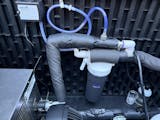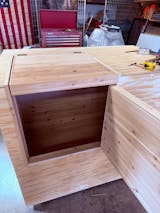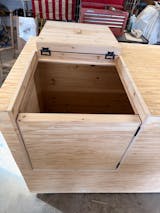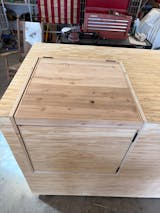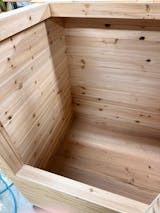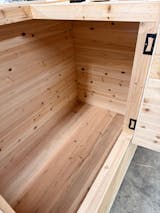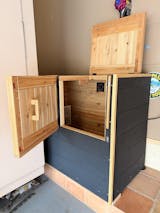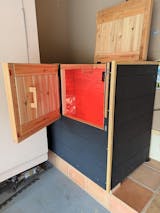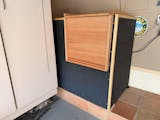How to Winterize Your DIY Cold Plunge (Without Freezing or Breaking Anything)
Whether you purchased your cold plunge or built it using one of my DIY designs, you'll want to review this article for how to winterize your plunge and prepare for the cold months. Winter can be brutal on chillers, pumps, plumbing lines, and filter housings — the last thing you want is your tub or plumbing freezing up, causing damage and having pipes burst.
The good news? With a little prep, you can either keep your cold plunge running all winter or safely shut it down without causing damage.
Let's walk through exactly how to do that 👍
You've got two options:
Pretty simple.
✅ Option A: Keep It Running All Winter
This is what I've personally done. If done right, it works great and keeps you plunging all winter long. It does require some extra monitoring and there is obviously additional risk involved... But so far mine has survived Minnesota winters for the past 3 years without issue.
✅ Option B: Drain and Shut It Down
Sounds pretty straightforward — but it’s not just draining the tank. The most important part is getting water out of all the plumbing lines and the filter housing.
-
With my Modular DIY Cold Plunge design → Everything drains easily. No tipping required. Just unhook everything to clear out all the water.
-
With the original stock tank build (or retail cold plunges)→ You may need to tip the tank upside down, on it's side, etc. to fully drain the plumbing. This isn't optional (IMO) – you don't want pipes freezing/bursting in the cold or anything growing in the lines when it starts to warm up.
Steps to Winterize Your Cold Plunge
1. The Most Important Thing: Keep Water Moving
Run your pump 24/7. Before we get into removing your chiller & other best practices for winter it is essential that the pump runs constantly. It's the most important piece of winterizing and you'll need to monitor things to ensure it doesn't stop.
Why? Still water freezes. Frozen water expands... which can crack the PVC/spa hose, break your filter housing and even damage the chiller (that is, if you disregard the advice below).
Issues that can pop up: power outages, extreme cold snaps, not changing your filter. Stay on top of all of these things.
2. Bypass & Remove the Chiller
Your chiller is the most expensive component of your entire cold plunge — so protecting it should be a priority. Running the pump 24/7 ensures that water is constantly flowing through it but if you live in climate with extreme cold, it's a good idea to remove it from the system altogether during the winter months.
When exactly? That's up for debate. I've left mine in until temperatures were consistently below freezing. This will ultimately come down to personal risk tolerance.
How do you remove it? You'll need to build a chiller bypass assembly. It's super simple – basically just some hose & unions that allow you to remove the chiller, and replace that loop with the new assembly. My plans cover exactly how to do this, but if you purchased your cold plunge from somewhere else you may need to experiment a bit to get it right.
Reminder! It's possible to leave your chiller connected. I've done it, but I can't officially say that you should. If you leave it connected, make sure water is constantly circulating through it (pump never stops). I know I'm being redundant, but I can't stress this enough.
3. Insulate & Add Heat Where Needed
You can make your own call on how far to take this, but the next step is insulating and even adding heating elements to your plumbing. FYI – Insulating your exposed lines isn’t just for extreme cold — it also helps control condensation in warmer months.
✔ Insulate any exposed PVC or spa hose
✔ In extreme climates, add heat tape or heat cable + a temperature-controlled outlet
Having seen a few winters, and helping thousands of people with their cold plunge... I can confidently say that the filter housing is one of the first things that can freeze up. The heat tape is a good idea here, along with an insulation sleeve. You'll also want to make sure that you stay on top of filter changes. Any slowing down of water can cause issues in the extreme cold. Another option would be to bypass the filter housing altogether and skip filtration for the winter.
4. Protect the Mechanical/Equipment Area
If your build has an enclosed, vented mechanical box or equipment bay, cut some pieces of foam to seal the vents for the winter. This keeps out snow, wind drafts, etc.
If you don't have an enclosed mechanical area, it is not an issue. Regularly check to make sure there isn't a buildup of snow around the components. I've used a leaf blower for this and its really easy.
5. Insulate the Tank & Use an Insulated Cover
You’d be amazed at how much heat is lost through the tank walls and the water surface. If your cold plunge is insulated, you're already ahead of the game - it'll be up to you if it's too late in the season to do this or not.
At the very least, I recommend an insulated cover. You can either buy one of these Rubbermaid Stock Tank Covers, or DIY one.
6. Monitor Temperature (Without Lifting the Lid)
One of the most important caveats to this is that keeping your cold plunge running requires monitoring of your system. This is not a "set it & forget it" situation.
Hopefully you are doing your daily plunge, and can keep an eye on things that way. It is also a good idea to get a wireless thermometer so you can check multiple times a day without needing to physically open up your tub.
7. Electrical & Safety Reminders
These are not winter-specific steps/tips but more so overall best practices. Make sure you plug everything into a GFCI-protected outlet, keep cords, smart plugs, and WiFi controllers out of snow or standing water and avoid using long extension cords if possible and if you do... make sure they are outdoor-rated & heavy-duty.
8. Final Tips Before the First Freeze
If you're going to keep it operational → Do a water change, clean your tub and change your filter now — winter can be a long stretch so it's best to start fresh.
If shutting down the plunge completely → drain everything and store components indoors if possible.







